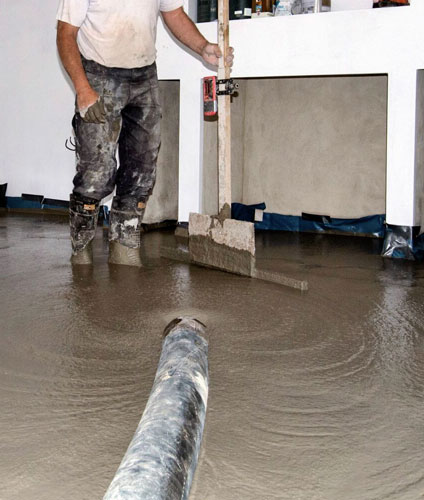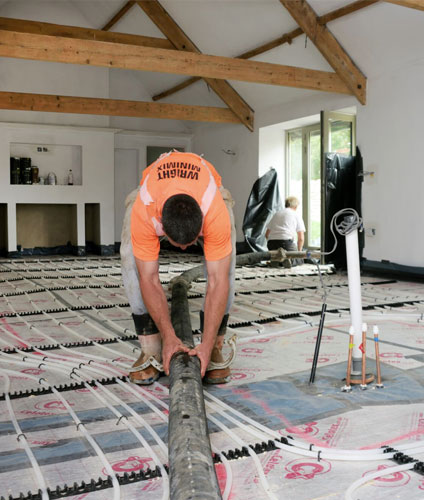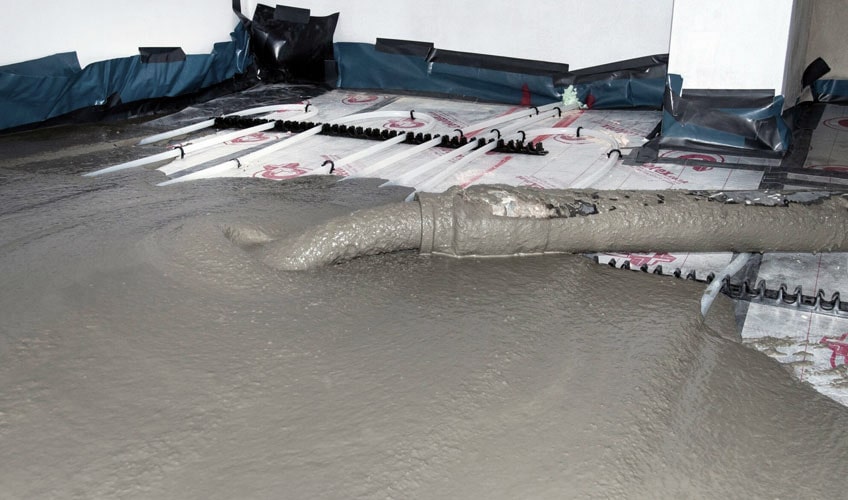Whether a house, deck, or bridge, every structure needs a strong footing to stand on.
Concrete footing lies at the very lowest point of a foundation. Responsible for supporting the weight of an entire building, the footing must be strong, durable, and sturdy enough to last years under heavy strain.
Poorly built concrete footing risks cracking or sinking into the ground. In extreme cases, it can even cause the building to collapse altogether!
For these reasons, laying out concrete footing correctly is a crucial part of the construction process.
Wright Minimix are specialists in all things concrete. We have extensive knowledge about using concrete for a variety of applications, and have years of experience working on projects across the south west.
In our guide to concrete footings, we cover everything you need to know about correctly laying a footing, from determining the right concrete mix to proper site preparation.
What are Concrete Footings?
Footings are the solid concrete at the very bottom of a structure. They distribute the weight of a building across an area, preventing it from sinking into the ground.
Footings are usually the first thing you build when starting a new construction project. Because they need to support a significant amount of weight, footings must be made of very strong concrete. It should be at least 3500 psi (pounds per square inch).
There are several different types of concrete footings: footing under a single column, footing under multiple columns, and wall footings.
Concrete has high compressive strength, meaning it can withstand heavy loads without fracturing, but low tensile strength. This means too much weight can cause it to elongate. For this reason, the concrete mix is usually reinforced with horizontal and vertical rebars.
What is the Best Concrete Mix for Footings?
The mix you use is one of the biggest factors in determining how strong your concrete footing will be.
Much of this revolves around the aggregate (the stone and sand used in the mix), as the aggregate is what gives concrete its strength. It makes up the bulk of the concrete and adds to its overall compressive strength. More stone means a stronger mix.
However, using overly coarse or oversized aggregates can cause “honeycombing.” Honeycombing refers to the gaps in the concrete caused by large pieces of aggregate sitting against the rebar, creating an effect that visually resembles a honeycomb. Honeycombing can be fixed by adding finer aggregates and more concrete to the mix, and by mixing the concrete more thoroughly.
For concrete footings, the best mix to use is:
- 1 part cement
- 2 parts sand
- 4 parts stone (aggregate by volume)
What aggregate size should you use for concrete footings?
The aggregate should be around 1/2 – 1 inch in size. After 28 days of curing, this mix will yield a 3500 psi.
Ready Mix Concrete for Concrete Footings
Although you can mix the concrete yourself, the most time and cost-effective way is to buy a ready mix. With ready-mix concrete, you can skip the laborious process of measuring and mixing and get straight to pouring.
At Wright Minimix, we create ready-mix concrete to your exact specifications. Because each mix is custom made, there is little or no wastage. There is also no need to have a labourer mix the cement on site, nor do you need to make space for storage.
How Do You Lay Concrete Footings?
The exact method will depend on the structure’s size, shape, and location. It’s also important to note that laying a footing is a complex process that requires significant expertise. Make sure you’re working with experienced professionals who can carry out the process correctly.
With that in mind, here is an overview of the general process:
1. Prepare the Site
Before you do anything, it’s important to analyse the condition of the soil on site. The size and dimension of your footing depends on the soil’s load bearing capacity. Soft or troublesome soil requires special care, as there is a high risk of the concrete sinking into it.
You should also clear out grass, roots, and debris from the idea, and identify the layout and corners of your foundation so it can be structured correctly.
2. Dig the Trench
Once you’ve determined how wide and deep the trench should be, you can begin digging.
The hole for your footings needs to be bigger than the foundation, so you and your workers have room to lay down the footings. There should be at least 2 feet on all sides.
The perimeter hole should be at least 2 feet wide by 2 to 3 feet deep. Make sure to clear out any remaining dirt and plantation afterwards.
3. Set the Rebar
Rebar support beams prevent the concrete from cracking or crumbling. You should set your rebar in place, then attach the grade pins on top. Each grade pin should be about 2 feet apart from one another, and a foot away from the corners.
Make sure that the rebar is an equal distance from the sides as it is from the base of your opening.
4. Mix and Pour the Concrete
If you’re using a ready mix, you can skip straight the pouring. Depending on the size and location of your site, a concrete pump may be your best option for this.
Wright Minimix has a fleet of concrete pumps available, big and small. This includes our compact Minipump, ideal for hard-to-access sites, as well as the largest concrete pump in the UK.
If you’re preparing the concrete yourself, make sure the ratio of cement, aggregate, and water is correctly measured out before mixing.
Once the concrete is prepared, pour it into the trench. This must be done within thirty minutes of mixing.
The final step is to protect your footing from moisture and damage with an industrial-quality, acrylic-based sealer.
Trust Wright Minimix for Your Concreting Needs
Need a reputable concrete supplier for your project? No matter what kind of structure you’re working on, we have the exact type of ready-mix concrete you need. Get in touch to arrange concrete for your footing today!




